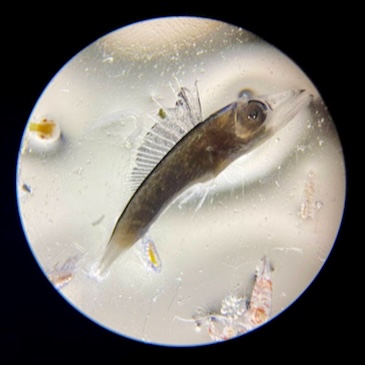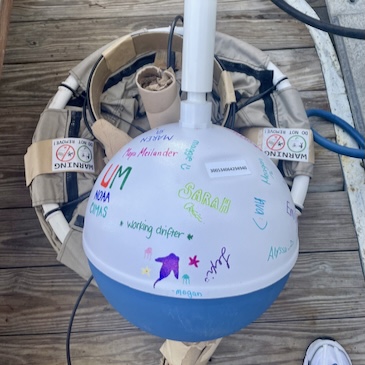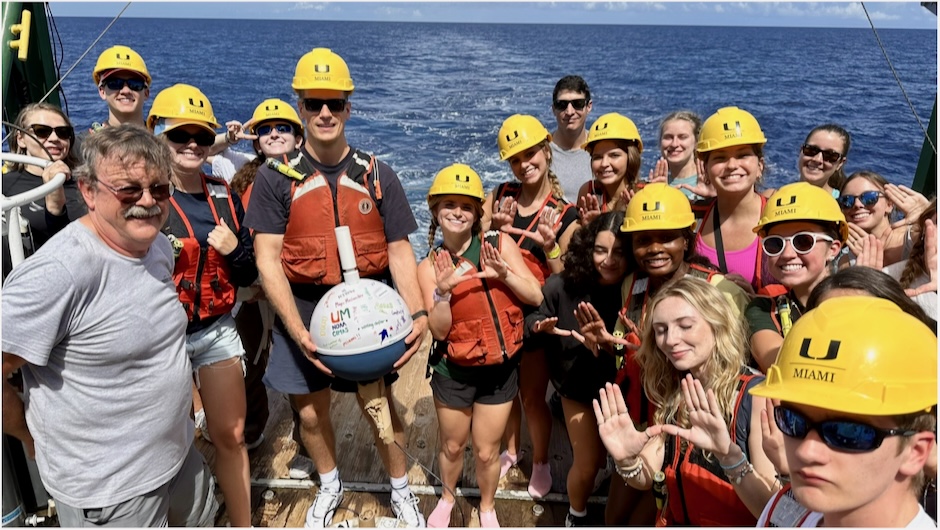University of Miami Rosenstiel School of Marine, Atmospheric, and Earth Science has conducted three FLOTSUM, i.e., Florida Ocean Time Series by Undergrads at UM, cruises aboard its research vessel the F.G. Walton Smith. FLOTSUM day cruises are conducted five times per year in the Florida Straits for training purposes and include approximately 20 undergraduate students per cruise. Marine science students gain valuable at-sea experience aboard a research vessel by being introduced to common oceanographic and atmospheric sampling techniques and the instruments used to collect measurements.
Philip Tuchen and Leah Chomiak, scientists at the University of Miami’s Cooperative Institute for Marine and Atmospheric Studies (CIMAS) and NOAA’s AOML, joined the recent FLOTSUM student demonstration cruises, led by Jim Happell, Ph.D., a research associate professor of ocean sciences. Philip and Leah participated as instructors for CTD, ADCP, and meteorological measurements and led drifter deployments on behalf of NOAA's Global Drifter Program and Adopt a Drifter Program.

Conductivity-temperature-depth (CTD) refers to a package of electronic instruments that measure these properties. Its primary function is to detect how the salinity (derived from conductivity) and temperature of the water column changes relative to depth. An acoustic Doppler current profiler (ADCP) measures water currents with sound, using a principle of sound waves called the Doppler effect. Scientists use the instrument to measure how fast water moves across the entire water column.
The Florida Current measured during FLOTSUM cruises is one of the fastest currents in the world and can reach velocities of 2 m/s (~4.5 mph).
In addition to CTD casts, the students are introduced to common oceanographic sampling techniques such as water sampling and filtering, weather data gathering, net tow for plankton collection, followed by microscope inspection, and oxygen titration.

“The students get the very unique chance at the beginning of their academic study to sail on a ship like the Walton Smith,” said Happell. “The Walton Smith is part of the US Academic Research Fleet (ARF), and this allows the students to see some typical deep ocean data, sampling, and analysis techniques. Having drifters to deploy is a great addition to the FLOTSUM cruises and allows us to participate in another important ocean observing technique.”
In a partnership with NOAA’s Global Drifter Program, each student cruise this year has deployed a drifter in the North Atlantic Ocean. Drifters are satellite-tracked surface drifting buoys that provide observations of near-surface currents, temperature, atmospheric pressure, winds, waves, and salinity. They are deployed globally and are guided by ocean currents as they collect data transmitted to overhead satellites. Tracking the location of drifters over time allows scientists to build a profile of ocean currents. A drifter's average lifetime is about 450 days, so continuing new deployments is crucial.
This is the second year NOAA and the University of Miami’s Rosenstiel School have partnered to deploy drifters on student cruises. NOAA provides a tracking link for each drifter to enable students to follow its trajectory long after deployment, providing a more hands-on approach to learning. Both drifters deployed in the Florida Straits in September 2023 are still active and currently close to the Azore islands (4101884 & 4101885).
“Deploying the drifters during the FLOTSUM cruises offers the students a valuable hands-on learning experience in sea-going oceanography. These cruises also contribute to the Global Drifter Program by helping maintain a globally dense array of drifter observations. The collaboration between the Rosenstiel School, CIMAS, and NOAA represents a mutually beneficial partnership.” said Tuchen.
In addition to partnering with NOAA’s Global Drifter Program, the Rosenstiel School is also participating in NOAA’s Adopt a Drifter Program by adopting the drifters they deployed.

The Adopt a Drifter Program began in December 2004 with the mission of establishing scientific partnerships between schools around the world and engaging students in activities and communication about ocean science. This free program provides teachers with an opportunity to integrate ocean observing data into their curriculum. Classrooms can track their adopted drifters in the ocean as they move freely with surface ocean currents. Students can also use the real-time data to predict currents and temperature profiles or plot the drifter’s track. This enables teachers and students to more easily make connections between the drifter data maps accessed online and other maps showing currents, winds, and other factors.
Drifter data is currently being used in the Introduction to Marine Science Lab (MSC112). The students use the data to calculate current velocities in the Florida Current.

